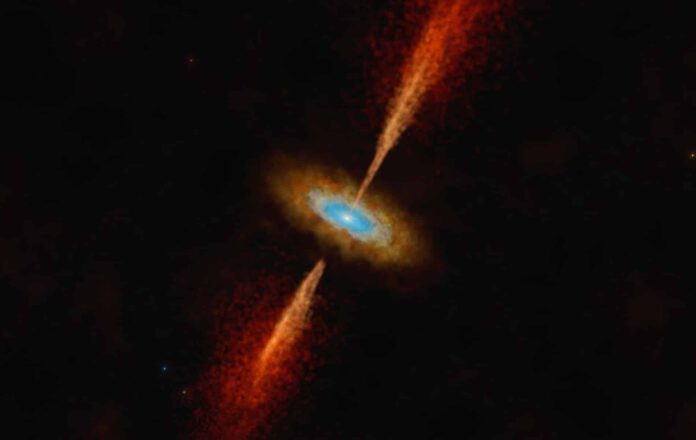
Situated in the Large Magellanic Cloud, a star is busily collecting matter from its surrounding, forming a disk of gas and dust that might give birth to planets at a later stage.
A Significant Discovery for Astronomers
For astronomers, this discovery is particularly exciting. Planetary formation disks are a relatively common finding in our Milky Way galaxy, yet researchers haven’t previously observed one in another galaxy before. However, with the help of the ALMA Observatory in Chile, the scenario has changed. “When I first saw evidence of a rotating structure in the ALMA data, I couldn’t believe we had discovered the first extra-galactic accretion disk. It was a special moment,” shared researcher Anna McLeod.
Introducing HH 1177
The star in question is located in the Large Magellanic Cloud, a galaxy approximately 160,000 light-years away. It was here that researchers discovered a young star named HH 1177 a few years back. What caught their attention about this young star was its emission of a matter stream, often referred to as a jet, indicating the presence of a so-called accretion disk. This type of disk consists of matter – gas and dust – attracted by the growing star. The matter doesn’t fall directly toward the star but rather compacts into a rotating disk around the star. The disk rotates faster closer to the center, a characteristic speed difference considered a key characteristic of an accretion disk.
Hunt for Confirmation
Although there were hints about the existence of an accretion disk around HH 1177, it remained unproven for some time. Researchers were merely incapable of measuring the disk’s distinctive dense gas motion around the star.
Role of ALMA
In their latest research, scientists present detailed measurements from ALMA, clearly validating the existence of an extra-galactic accretion disk. ALMA achieved this by examining the light frequency emitted by the gas in the accretion disk. “Depending on how fast the light-emitting gas is moving toward or away from us, the frequency of the received light changes,” explained researcher Jonathan Henshaw. “It’s the same phenomenon that causes an ambulance siren’s pitch to change as it speeds past you, first increasing then decreasing.”
ALMA’s frequency measurements unveiled the expected rotation of gas in an accretion disk, marking the discovery of the very first extra-galactic accretion disk. “We know that disks are crucial for the formation of stars and planets in our galaxy, and here we see direct evidence of this in another galaxy for the first time,” McLeod said.
Differences and Similarities
The first extra-galactic accretion disk found appears to be very similar to the planet-forming disks we have seen before in our own galaxy, but it also has some differences. For instance, the extra-galactic accretion disk seems to resist fragmentation more effectively. Researchers believe this is because the Large Magellanic Cloud, and consequently the disk, has a lower metal content than the Milky Way and its planet-forming disks.
Researchers are optimistic about discovering more extra-galactic accretion disks in the future. Along with ALMA, the Next Generation Very Large Array (ngVLA), expected to be fully operational by 2037, might play a role in this. By identifying more young stars and planet-forming disks in other galaxies, scientists hope to gain a more comprehensive understanding of how stars and planets are formed.











